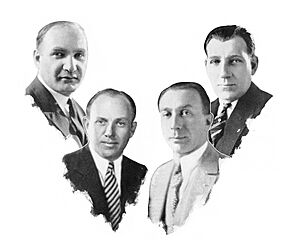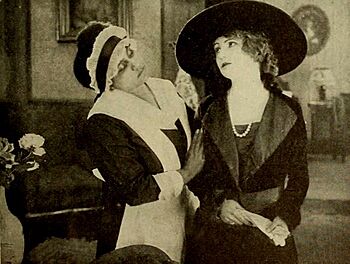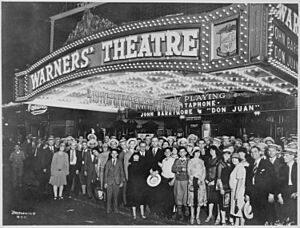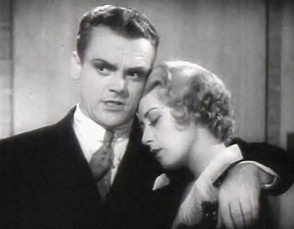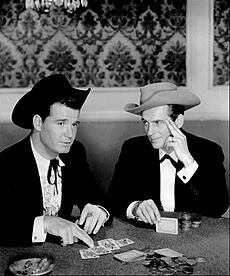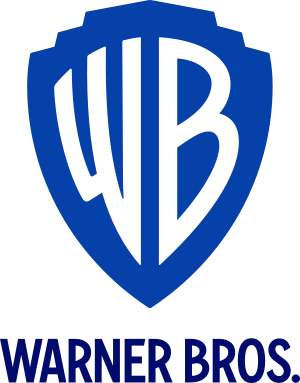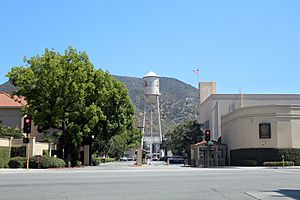Warner Bros. facts for kids
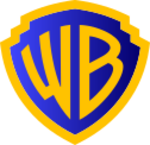
Logo used since 2023
|
|
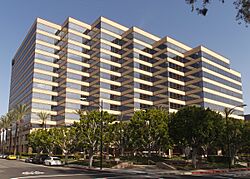
Warner Bros.' studio offices in Burbank, California
|
|
|
Trade name
|
Warner Bros. |
|---|---|
|
Formerly
|
|
| Subsidiary | |
| Industry | Entertainment |
| Predecessor | Warner Features Company |
| Founded | April 4, 1923 |
| Founders |
|
| Headquarters | 4000 Warner Boulevard,
,
United States
|
|
Area served
|
Worldwide |
|
Key people
|
|
| Products | |
| Brands |
|
| Revenue | |
|
Operating income
|
|
|
Number of employees
|
est. 8,000 (2014) |
| Parent |
|
| Divisions |
|
| Subsidiaries |
|
Warner Bros. Entertainment Inc. (often called Warner Bros. or WB) is a big American company that makes movies and TV shows. Its main office is in Burbank, California, at the Warner Bros. Studios complex. It is a major part of Warner Bros. Discovery.
The company was started on April 4, 1923, by four brothers: Harry, Albert, Sam, and Jack Warner. Warner Bros. quickly became a leader in the American film industry. Over time, it also started making animation, television shows, and video games. It is one of the "Big Five" main American movie studios.
Warner Bros. is famous for its movie division, the Warner Bros. Motion Picture Group. This group includes Warner Bros. Pictures, New Line Cinema, Warner Bros. Pictures Animation, and Castle Rock Entertainment. The company also has the Warner Bros. Television Group. Bugs Bunny, a character from the Looney Tunes cartoons, is the company's official mascot.
Contents
- How Warner Bros. Started
- The Era of Sound and Color
- Facing Challenges and New Stars
- Warner's Cartoons
- World War II and Beyond
- Warner Bros. on Television and in Music
- New Owners and Modern Era
- Warner Bros. Discovery
- What Warner Bros. Does Today
- Important Leaders
- How Warner Bros. Distributes Films Around the World
- Warner Bros. Film Library
- The Warner Bros. Archives
- See also
How Warner Bros. Started
The company's name comes from the four Warner brothers who founded it: Harry, Albert, Sam, and Jack Warner. The three older brothers, Harry, Albert, and Sam, moved to the United States from Poland in 1889. Jack, the youngest, was born in Canada.
The older brothers first got into the movie business by buying a movie projector. They showed films in mining towns in Pennsylvania and Ohio. Sam and Albert Warner spent $150 to show early films like Life of an American Fireman and The Great Train Robbery. In 1903, they opened their first movie theater, the Cascade, in New Castle, Pennsylvania.
In 1904, the Warners started the Duquesne Amusement & Supply Company in Pittsburgh to distribute films. By the time of World War I, they began making their own movies. In the early 1920s, they got their first studio in Hollywood. Sam and Jack made the movies, while Harry and Albert handled the money and distribution in New York City.
On April 4, 1923, with some financial help, they officially became Warner Bros. Pictures, Incorporated.
One of their first big successes came from a dog named Rin Tin Tin. This dog was brought from France after World War I by an American soldier. Rin Tin Tin's third movie, Where the North Begins, was so popular that Jack Warner signed the dog to star in more films for $1,000 a week. Rin Tin Tin became the studio's biggest star. Jack called him "The Mortgage Lifter" because he helped the studio make so much money.
Another important person was Ernst Lubitsch, who became a top director. His film The Marriage Circle was the studio's most successful movie in 1924. By the end of 1924, Warner Bros. was one of Hollywood's most successful independent studios. They competed with bigger studios like First National, Paramount, and MGM.
With new money from Wall Street, the Warners bought the Vitagraph Company in 1924, which helped them distribute films across the country. In 1925, they also started a successful radio station, KFWB, in Los Angeles.
The Era of Sound and Color
Warner Bros. was a leader in making films with synchronized sound, also known as "talking pictures" or "talkies." In 1925, Sam Warner pushed for the studio to add sound to their movies. They signed a deal with Western Electric and created Vitaphone.
In 1926, Vitaphone started making films with music and sound effects. Their first big film was Don Juan, starring John Barrymore. This movie was silent, but it had many Vitaphone short films at the beginning with music.
Despite Don Juan not making a lot of money, Warner Bros. took a big step and released The Jazz Singer in 1927, starring Al Jolson. This movie had some spoken dialogue and Jolson singing, which was a huge hit. It marked the beginning of "talking pictures" and the end of the silent movie era. Sadly, Sam Warner passed away the night before the movie premiered. Jack Warner then became the sole head of production.
Because The Jazz Singer was so successful, the studio had a lot of money. They bought a much larger studio in Burbank. They also expanded by buying the Stanley Corporation, a big chain of movie theaters. This gave them a share in a rival company, First National Pictures. In 1928, Warner Bros. bought more shares of First National.
In 1928, Warner Bros. released Lights of New York, the first movie that was entirely a "talkie." Its success made the whole movie industry switch to sound almost overnight. By the end of 1929, all major studios were making only sound films.
Warner Bros. also led the way in color films. In 1929, they released On with the Show!, the first all-color, all-talking movie. This was followed by Gold Diggers of Broadway. The success of these movies started a "color revolution" in Hollywood. Many of their early color films were musicals.
In 1930, Harry Warner bought several music publishers to create Warner Bros. Music. He also bought radio companies and foreign sound patents.
Facing Challenges and New Stars
By 1931, the Great Depression started to affect the studio, causing them to lose money. Musicals also became less popular. Warner Bros. had a contract to make two more films in Technicolor, so they produced the first horror films in color: Doctor X (1932) and Mystery of the Wax Museum (1933).
In 1933, Warner Bros. released 42nd Street, a very successful musical. This movie helped save the company from financial trouble. The studio then made more profitable musicals, many starring Ruby Keeler and Dick Powell.
When musicals declined again, Warner Bros. focused on more realistic stories, especially gangster films. Their first gangster movie, Little Caesar, was a big hit and made Edward G. Robinson a star. The next film, The Public Enemy, made James Cagney another top star for the studio.
Another important film was I Am a Fugitive from a Chain Gang, based on a true story. It starred Paul Muni and made audiences question the legal system. After appearing in The Man Who Played God, Bette Davis became a major star.
In 1933, Franklin D. Roosevelt became president and started the New Deal, which helped the economy. This allowed Warner Bros. to become profitable again. However, the studio's head of production, Darryl F. Zanuck, left to start his own company. Harry Warner then increased salaries for other studio employees.
In 1934, a fire at the Burbank studio destroyed many early films. In 1935, Harry Warner was involved in a legal case about trying to control movie theaters unfairly. He sold the company's movie theaters, and the case was closed.
By 1936, Warner Bros. started signing actors who fit tough, working-class roles, like James Cagney, Joan Blondell, Edward G. Robinson, and Barbara Stanwyck. The studio also had to follow stricter rules about what could be shown in movies, so they started making more historical dramas and adventure films. In 1936, Humphrey Bogart signed with the studio, but he was often cast as a villain at first.
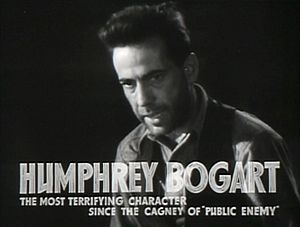
Hal B. Wallis took over from Zanuck in 1933. The studio's historical dramas, melodramas (often called "women's pictures"), and adventure films, starring actors like Bette Davis, Olivia de Havilland, Paul Muni, and Errol Flynn, helped them avoid problems with censors. Bette Davis became one of the studio's biggest stars, sometimes called "The Fifth Warner Brother."
In 1937, the studio hired a radio announcer named Ronald Reagan, who later became the President of the United States. Reagan started in smaller films but became a top star after his performance in Kings Row (1942).
Warner's Cartoons
Warner Bros. started its cartoon division in 1930. Early animators like Hugh Harman and Rudolf Ising created characters like Bosko for the Looney Tunes series and Merrie Melodies.
Later, a new team of animators, including Friz Freleng, Tex Avery, Bob Clampett, and Chuck Jones, developed a fast-paced, funny style for their cartoons.
In 1935, Tex Avery directed Porky Pig cartoons, making Porky the studio's first animated star. Other famous characters like Daffy Duck (1937), Elmer Fudd (1940), Bugs Bunny (1940), and Tweety (1942) also became very popular. By 1942, Warner Bros. cartoons were more successful than Walt Disney Studios' animated shorts.
Warner Bros. bought the cartoon unit in 1944 and renamed it Warner Bros. Cartoons. However, the studio's leaders didn't always pay much attention to the cartoon division. Jack Warner even mistakenly thought they made Mickey Mouse cartoons! He sold off many of their older cartoons before August 1948 for a very low price.
The cartoon studio continued until 1969. Characters like Bugs Bunny, Daffy Duck, Tweety, Sylvester, and Porky Pig became very important to the company's image. Bugs Bunny is still a mascot for Warner Bros. and Six Flags theme parks. In 1979, the success of the movie The Bugs Bunny/Road Runner Movie, which used old cartoon clips, led Warner Bros. to start Warner Bros. Animation to make new cartoons.
World War II and Beyond
During World War II, Warner Bros. made many films that supported the war effort. Harry Warner oversaw anti-German films like The Life of Emile Zola (1937) and Confessions of a Nazi Spy (1939).

During the war, the studio made famous movies like Casablanca; Now, Voyager; and Yankee Doodle Dandy (all from 1942). At the premieres of Yankee Doodle Dandy, audiences bought $15.6 million in war bonds to help the war effort. By the end of the war, $20 million in war bonds were purchased through the studio.
In 1943, actress Olivia de Havilland sued Warner Bros. because she felt her contract was too long. The court ruled in her favor, which helped many actors get out of unfair long-term contracts.
After the war, Warner Bros. continued to do well and created new stars like Lauren Bacall and Doris Day. In 1948, the Supreme Court ruled that movie studios could not own both film production companies and movie theaters. This meant Warner Bros. had to separate its film production from its theater business.
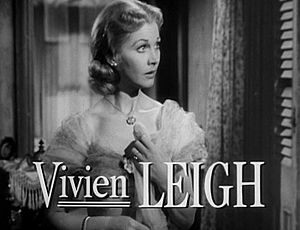
In the early 1950s, television became a big threat to movies. In 1953, Jack Warner tried making 3D films, starting with House of Wax. However, 3D movies quickly lost their popularity.
In 1956, Jack Warner sold the rights to all of the studio's films made before 1950 to Associated Artists Productions. Later, these films became part of the Turner Entertainment Co. library.
In May 1956, the Warner brothers announced they were selling Warner Bros. Jack Warner secretly bought back his shares and became the company's new president.
Warner Bros. on Television and in Music
By 1949, with television becoming more popular, Harry Warner wanted to make TV shows. However, the government rules at the time didn't allow it.
On March 21, 1955, the studio finally started making television shows through its successful Warner Bros. Television unit. They made a weekly show for ABC called Warner Bros. Presents. Their next show, Cheyenne, was television's first hour-long Western. The success of these TV series helped make up for losses in the movie business. Warner Bros. also produced popular detective shows like 77 Sunset Strip (1958–1964).
On March 19, 1958, the studio started Warner Bros. Records, a music label. They released recordings by their TV stars and soundtracks from their shows. Warner Bros. already owned many music publishing companies. In 2004, Warner Bros. Records was sold and later renamed Warner Records in 2019.
In 1963, Warner Bros. bought Frank Sinatra's Reprise Records. This deal brought Morris "Mo" Ostin into the company, who became very important to Warner Bros. Records.
New Owners and Modern Era
Warner Bros. did well in the late 1950s by adapting popular plays into movies like The Bad Seed (1956) and My Fair Lady (1964). The soundtrack for My Fair Lady also made Warner Bros. Records very profitable.
In November 1966, Jack Warner sold control of the studio and music business to Seven Arts Productions for $32 million. The company was renamed Warner Bros.-Seven Arts. Jack Warner stayed on as president for a short time. In 1967, the movie Bonnie and Clyde was a big success, making Warner Bros. profitable again.
Two years later, in 1969, Kinney National Company bought Warner Bros.-Seven Arts. Kinney also owned DC Comics. Ted Ashley became the new studio head and changed the name back to Warner Bros. Inc. Jack Warner was upset by this sale and left to make independent films. He retired in 1973.

Under new management, Warner Bros. focused on working with big stars like Paul Newman, Robert Redford, Barbra Streisand, and Clint Eastwood. This helped the studio succeed through the 1970s and 1980s. They made hits like Blazing Saddles, A Clockwork Orange, The Exorcist, and films based on Superman, Batman, and Wonder Woman from DC Comics.
In 1973, Warner Bros. and 20th Century Fox worked together to make the film The Towering Inferno. This partnership was very successful and led to other studios working together on films.
Kinney National Company later changed its name to Warner Communications. In the 1970s and 1980s, Warner Communications expanded into other businesses, like the video game company Atari, Inc. and the Six Flags theme parks.
In 1989, Warner Communications merged with the publishing company Time Inc. to form Time Warner. This was a big merger that created a huge media company.
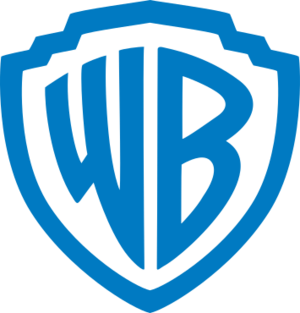
In 1993, Warner Bros. Family Entertainment was created to make family-friendly and animated films. In 1995, Warner Bros. and Tribune Company launched The WB Television Network, which became popular with teenage viewers for shows like Buffy the Vampire Slayer and Smallville. In 2006, The WB merged with another network, UPN, to create The CW Television Network.
In 1996, Turner Pictures became part of Warner Bros. This brought films like City of Angels and You've Got Mail to the studio.
In 1998, Warner Bros. celebrated its 75th anniversary. In 2003, Time Warner reorganized its assets under Warner Bros. Entertainment Inc.
In the late 1990s, Warner Bros. got the rights to the Harry Potter books. They released the first movie, Harry Potter and the Sorcerer's Stone, in 2001. The Harry Potter film series became one of the highest-grossing film series of all time.
In 2018, Warner Bros.' parent company, Time Warner, was bought by AT&T and renamed WarnerMedia. In 2019, Warner Bros. revealed an updated version of its shield logo.
Warner Bros. Discovery
On April 8, 2022, AT&T separated WarnerMedia, and it merged with Discovery Inc. to form Warner Bros. Discovery. This new company is led by David Zaslav.
In March 2022, Warner Bros. started a campaign for its 100th anniversary in 2023, with the slogan "100 Years of Storytelling." In December 2022, the main anniversary campaign launched with the slogan "Celebrating Every Story." This campaign includes special events and new short films that recreate Warner Bros. classics.
In November 2022, James Gunn and Peter Safran became the co-CEOs of DC Films, which was renamed "DC Studios." This studio became a separate division within Warner Bros. Discovery.
What Warner Bros. Does Today
Warner Bros. Entertainment has three main parts: Motion Picture Group, Television, and other entertainment businesses.
The Motion Picture Group includes the company's main movie studios, such as Warner Bros. Pictures, New Line Cinema, and Castle Rock Entertainment.
| Motion Picture Group | Television Group | Entertainment |
|---|---|---|
|
|
|
Important Leaders
Chairman of the board
- Robert A. Daly (1980–1999)
- Barry Meyer (1999–2013)
- Kevin Tsujihara (2013–2019)
- Ann Sarnoff (2019–2022)
Vice chairman
- Edward A. Romano (1994–2016)
Presidents
- Terry Semel (1994–1999)
Chief executive officers
- Robert A. Daly (1980–1999)
- Barry Meyer (1999–2013)
- Kevin Tsujihara (2013–2019)
- Ann Sarnoff (2019–2022)
Chief operating officers
- Terry Semel (1982–1994)
- Barry Meyer (1994–1999)
How Warner Bros. Distributes Films Around the World
From 1971 to 1987, Warner Bros. worked with Columbia Pictures to distribute films internationally. They also distributed films from other companies in some countries. Warner Bros. ended this partnership in 1988.
In 1987, Buena Vista Pictures Distribution made a deal with Warner Bros. International to release Disney films in other countries. However, Disney decided to distribute its own films starting in 1992.
Since January 1, 2021, Universal Pictures distributes Warner Bros. films in places like Hong Kong, Mexico, Australia, and New Zealand. Also, since 2024, Warner Bros. handles the distribution of Universal Pictures films in Brazil, India, and the Philippines.
In August 2022, Warner Bros. Pictures made a deal to distribute Amazon MGM Studios films outside the United States. This deal included working together on marketing and advertising. This agreement ended in 2025.
Warner Bros. Film Library
Warner Bros. has collected a huge number of films, cartoons, and TV shows through mergers and buying other companies. As of 2022, Warner Bros. owned over 145,000 hours of programming, including 12,500 feature films and tens of thousands of TV episodes.
In 1956, Warner Bros. sold most of its films and cartoons made before 1950 to Associated Artists Productions (a.a.p.). This included the Popeye cartoons. Later, a.a.p. was sold to United Artists (UA), and then to Metro-Goldwyn-Mayer (MGM).
In 1986, Turner Broadcasting System bought MGM. Turner Entertainment kept the MGM films and TV shows made before May 1986, as well as the a.a.p. library.
In 1989, Warner Communications bought Lorimar-Telepictures Corporation, which added more films to their collection.
In 1991, Turner Broadcasting System bought the animation studios Hanna-Barbera and Ruby-Spears. Later, Turner also bought Castle Rock Entertainment and New Line Cinema. On October 10, 1996, Time Warner bought Turner Broadcasting System. This brought Warner Bros.' pre-1950 film library back to the studio after 46 years.
In 2008, New Line Cinema became part of Warner Bros. Pictures.
The Warner Bros. Archives
The University of Southern California Warner Bros. Archives is the largest collection from a single studio in the world. It was given to USC in 1977 by Warner Communications. The archives contain records that show how Warner Bros. made films from its early days until 1968. This gives a full picture of how movies were made during the Golden Age of Hollywood.
See also
 In Spanish: Warner Bros. para niños
In Spanish: Warner Bros. para niños
- Warner Bros. Studios, Burbank
- Warner Bros. Studio Tour Hollywood
- Warner Bros. Home Entertainment
- Warner Bros. Family Entertainment
- Warner Bros. Television Studios
- Warner Bros. Discovery Global Experiences
- List of Warner Bros. short subjects
- Warner Bros. Animation
- Warner Bros. Studios, Leavesden


